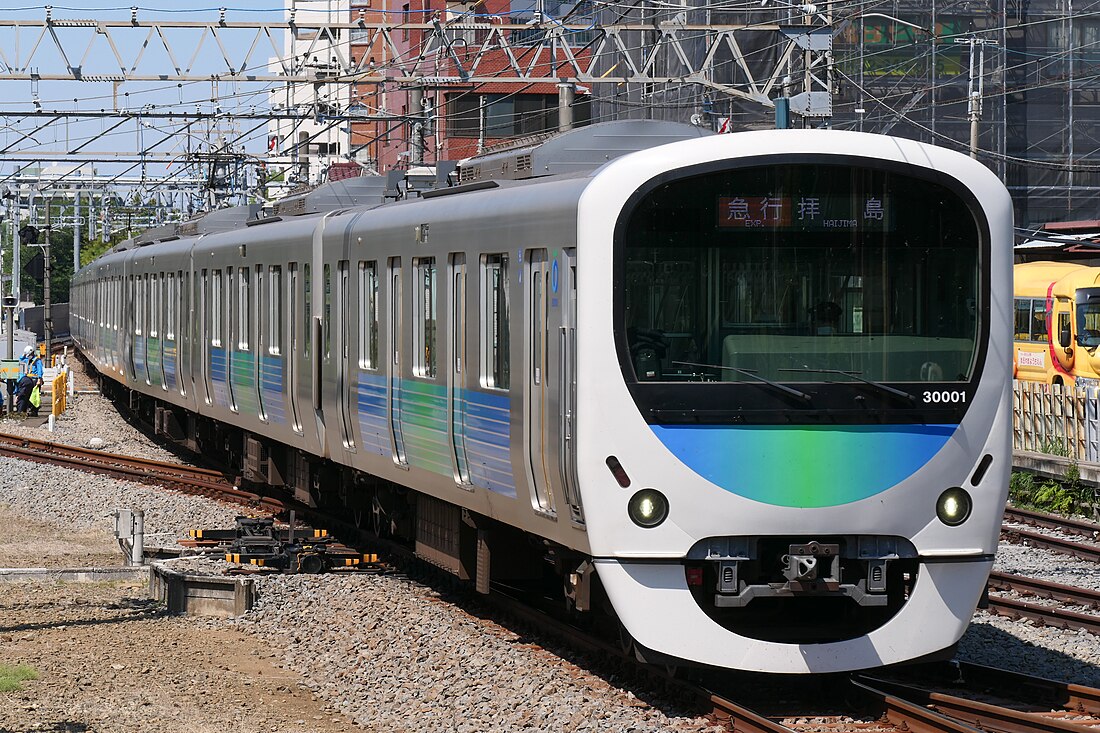Top Qs
Timeline
Chat
Perspective
Seibu Haijima Line
Railway line in Tokyo, Japan From Wikipedia, the free encyclopedia
Remove ads
The Seibu Haijima Line (西武拝島線, Seibu Haijima-sen) is a railway line in Tokyo, Japan, operated by Seibu Railway.[1] It acts as a branch line of the Seibu Shinjuku Line, with direct trains to Seibu-Shinjuku Station in Tokyo.
This article needs additional citations for verification. (August 2015) |
Remove ads
Haijima Liner
Haijima Liner is a reserved seat express service between Haijima and Seibu-Shinjuku.[2] The service commenced in Spring 2018 using the Seibu 40000 series trainsets.[3]
As of 16 March 2024[update], inbound services operate only on weekday mornings, stopping at all stations between Haijima and Kodaira, then operate non-stop to Takadanobaba and Seibu-Shinjuku. There are 3 trips with running time between 44 and 50 minutes.[4]
Outbound services operate every day including weekends and public holidays. From Seibu-Shinjuku trains stop at Takadanobaba, then non-stop to Kodaira, then all stations to Haijima. Trains depart Seibu-Shinjuku hourly between 17:15 and 22:15, with running time between 44 and 49 minutes.[4]
As well as a regular fare ticket, a reserved seat ticket is required at a cost of 510 yen (260 yen for children under 12years old).[2]
Remove ads
Stations
- O: stop
- SE: Semi Express (準急, Junkyū)
- E: Express (急行, Kyūkō)
- HL: Haijima Liner (拝島ライナー, Haijima Rainā)[5]
All trains on this line stop at every station.
Remove ads
Rolling stock

History
This section needs additional citations for verification. (January 2018) |
- 2 November 1928: Opened as Tamako Railway from Hagiyama to Moto-Kodaira (near Kodaira).
- 15 August 1932: Electrified at 600 V DC from Hagiyama to Moto-Kodaira.
- 12 March 1940: Tamako Railway merged with Musashino Railway (present-day Seibu Railway).
- 15 November 1949: Moto-Kodaira Station merged into Kodaira Station.
- 15 May 1950: Jōsui Line opened from Ogawa to Tamagawa-Jōsui. Omebashi and Tamagawa-Jōsui stations opened.
- 12 October 1954: Electrified at 1,500 V DC from Ogawa to Tamagawa-Jōsui.
- 18 March 1955: Electrification raised to 1,500 V DC between Kodaira and Hagiyama.
- 1 September 1962: Josui Line opened from Hagiyama to Ogawa. Renamed Jōsui Line from Kodaira to Hagiyama.
- 7 November 1967: Double-tracked from Kodaira to Hagiyama.
- 15 May 1968: Haijima Line opened from Tamagawa-Jōsui to Haijima, Seibu-Tachikawa station opened. Jōsui Line renamed Haijima Line.
- 25 March 1979: Omebashi Station renamed Higashi-Yamatoshi Station.
- 7 December 1979: Double-tracked from Hagiyama to Ogawa.
- 12 December 1983: Musashi-Sunagawa Station opened.
- 1 December 1983: Double-tracked from Musashi-Sunagawa to Seibu-Tachikawa.
- 5 March 1987: Nishi-Ogawa passing loop opened. Double-tracked from Nishi-Ogawa to Higashi-Yamatoshi.
- 2 November 1988: Double-tracked from Higashi-Yamatoshi to Tamagawa-Jōsui.
- 29 March 1991: Double-tracked from Ogawa to Nishi-Ogawa, Nishi-Ogawa passing loop abolished.
- 14 June 2008: Haijima Rapid service started. The service stopped at: Kodaira, Tamagawa-Jōsui, Musashi-Sunagawa, Seibu-Tachikawa and Haijima stations.
- 30 June 2012: Haijima Rapid service abolished.[7]
Remove ads
References
External links
Wikiwand - on
Seamless Wikipedia browsing. On steroids.
Remove ads

